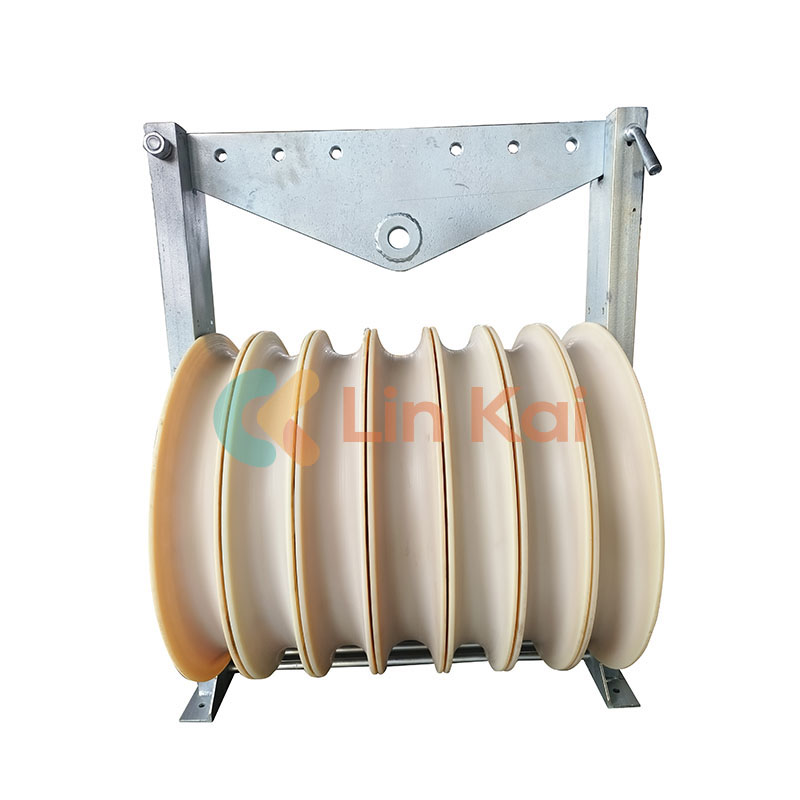Single vs. Multiple Sheave Large Diameter Stringing Blocks: Key Differences and Applications
2024-05-15
In power line construction and maintenance, large diameter stringing blocks are essential for guiding and managing conductors during stringing operations. These blocks come in various configurations, primarily categorized into single sheave and multiple sheave blocks. Understanding the differences between these types is crucial for selecting the right equipment for specific projects. Here’s an in-depth look at the key differences and applications of single and multiple sheave large diameter stringing blocks.
1. Basic Design and Structure
Single Sheave Stringing Blocks:
- Design: Consist of one sheave (wheel) through which the conductor is guided.
- Structure: Typically simpler and lighter in design, making them easier to handle and transport.
Multiple Sheave Stringing Blocks:
- Design: Feature two or more sheaves arranged in parallel or in a series.
- Structure: More complex and robust, designed to accommodate multiple conductors simultaneously or to reduce the angle of bend on a single conductor.
2. Application and Use Case
Single Sheave Stringing Blocks:
- Primary Use: Ideal for projects involving single conductor stringing.
- Applications: Used in straightforward power line installations where only one conductor needs to be managed.
Multiple Sheave Stringing Blocks:
- Primary Use: Suitable for projects requiring the stringing of multiple conductors simultaneously.
- Applications: Commonly used in bundle conductor installations, high-voltage power lines, and complex transmission projects where multiple conductors are strung in parallel.
3. Load Distribution and Tension Management
Single Sheave Stringing Blocks:
- Load Distribution: Handles the load of a single conductor, distributing the weight across one sheave.
- Tension Management: Adequate for projects with lower tension requirements due to the single conductor.
Multiple Sheave Stringing Blocks:
- Load Distribution: Distributes the load across multiple sheaves, which can better manage the weight and tension of multiple conductors.
- Tension Management: Ideal for high-tension projects, as the multiple sheaves help in reducing stress on each individual conductor and on the equipment.
4. Flexibility and Versatility
Single Sheave Stringing Blocks:
- Flexibility: Less flexible in terms of handling multiple conductors but easier to use and more versatile for straightforward tasks.
- Versatility: Suitable for a wide range of standard power line installations.
Multiple Sheave Stringing Blocks:
- Flexibility: More flexible for complex installations, offering the ability to manage multiple conductors and varying tension requirements.
- Versatility: Highly versatile for specialized tasks, including high-voltage and bundle conductor installations.
5. Cost and Maintenance
Single Sheave Stringing Blocks:
- Cost: Generally more cost-effective due to their simpler design and lower material requirements.
- Maintenance: Easier and less frequent maintenance needs, given fewer moving parts.
Multiple Sheave Stringing Blocks:
- Cost: Higher initial cost due to the complexity and additional materials.
- Maintenance: Requires more maintenance due to the increased number of moving parts and potential points of wear.
Conclusion
Choosing between single and multiple sheave large diameter stringing blocks depends on the specific needs and complexity of your power line project. Single sheave blocks are ideal for straightforward, single conductor installations where ease of use and cost-efficiency are prioritized. In contrast, multiple sheave blocks are suited for more complex, high-tension projects involving multiple conductors, offering enhanced load distribution, safety, and versatility.
By understanding the differences between these two types of stringing blocks, project managers and engineers can make informed decisions that optimize performance, safety, and efficiency in power line construction and maintenance. Whether it’s the simplicity and cost-effectiveness of single sheave blocks or the robustness and flexibility of multiple sheave blocks, selecting the right equipment is key to ensuring successful project outcomes.



